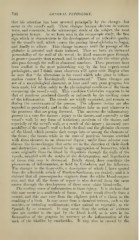Page 690 - My FlipBook
P. 690
700 GENERAL PATHOLOGY.
that his attention has been arrested principally by the changes that
occur in the vessel's wall. These changes become obvious in various
ways, and constitute, in the microscopic study of the subject, the most
prominent factors. As we have seen in the microscopic study, the first
sign which is characteristic is the development of an adhesive quality
by the vessel's wall, which causes the passing blood-globules to linger,
and finally to adhere. This change increases until the passage of the
globules is arrested and stasis induced. Then we have an increased
permeability of the wall of the vessel ; its fluid contents pass through
in greater quantity than normal, and in addition to this the white glob-
ules pass through the wall in abnormal numbers. These processes have
been studied in the most painstaking way by the best experimental
pathologists, and I think most observers will agree with Ziegler Avhen
he says that " the alterations in the vessel which take place in inflam-
mation cannot be histolooicallv demonstrated," These chano;es are
not of a morphological character, at least until very great progress has
been made, but relate solely to the physiological condition of the tissue
composing the vessel's wall. This condition Cohnheim su})poses to be
that of paralysis produced directly or indirectly by the exciting cause
of the inflammation. The vessels are widely expanded, and remain so
during the continuance of the process. The adjacent tissues are also
regarded as paralyzed; and in this condition take no part ^^•hatever in
the processes that are going forward. This narrows the inflannnatory
process to a very few factors : injury to the tissues, and especially to the
vessel's wall, by any form of irritation paralysis of the tissues, and
;
especially of the vessel's wall, as a result of this injury ; increased per-
meability of the vessel's wall to both the fluid and the globular elements
of the blood, which permits their escape into or among the elements of
the tissue ; the tissues while in the state of paralysis become crowded
wath these elements to an abnormal degree ; under these adverse con-
ditions the tissue-changes that occur are in the direction of their death
and destruction pus is formed by the aggregation of leucocytes, which
;
come originally from the blood by diapedesis through the walls of the
vessels, mingled Avith the results of the disintegration and liquefaction
of tissue that may be destroyed. Briefly stated, these constitute the
phenomena of inflannnation, as held by Cohnheim and his followers.
The changes in the tissue-cells, a description of which I have quoted
from the admirable article of Burdon-Sanderson, are denied ; and it is
claimed that all ])ns-corpuscles originate from the white blood-corpus-
cles, and that all the tissue of repair is also derived from the same
source through the development of these same white blood-cells.
TJie exciting cause of wfariunation /.s tis.s'ue iiijiiry. It is obvious that
this may occur in a multitude of forms. It may result directly from a
wound, and this may vary from the slightest ]irick of a thorn to the
crushing of a limb. It may occur from a chemical irritant, such as the
caustics, or irritating medicaments, either animal or vegetable, as the
Spanish fly or mustard. It may occur from the action of irritants
that are carried to the spot by the blood itself, as is seen in in-
flammation of the gingiva? by mercury or the inflammation of the
neck of the bladder by cantharides. It may also be caused by the


